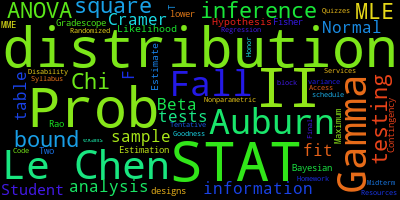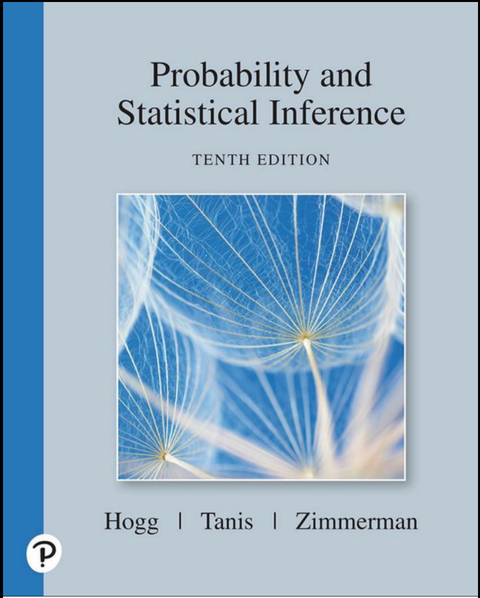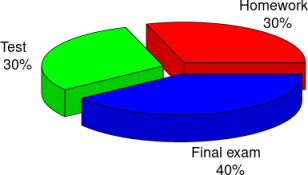- Welcome to choose this class. More information will come in late summer 2021.

- 2021 Fall, Auburn University
- Contacts
- Course description
- Textbook
- Coverage
- Co-requisite
- Prerequisite
- Homework
- Midterm test
- Due dates for homework and tests
- Final exam
- Attendance
- Assessment
- Slides
- Tentative schedule
- Gradescope
- Feedback
- Honor code
- Accessibility
- Harassment and Discrimination
- Acknowledgement
| Lecture Instructor | Dr. Le Chen |
| le.chen@auburn.edu | |
| Class Time | MWF, 12:00 PM -- 12:50 PM |
| Class Room | PARKR 305 |
| Office hours | MWF, 13:00 -- 13:50 |
-
When you send us emails, please do include the keyword
STAT 3610in the subject field of your email to ensure a timely response.
Statistics is the science concerned with developing and studying methods for collecting, analyzing, interpreting and presenting empirical data. Statistics is a highly interdisciplinary field; research in statistics finds applicability in virtually all scientific fields and research questions in the various scientific fields motivate the development of new statistical methods and theory.
This course is the second course of the two-semester sequential courses -- STAT 3600 and STAT 3610. In the previous course we studied probability, which lays foundation for this course. In this course, we will study some fundamental ideas in statistics and various tools in statistical inference. In particular, we will cover parameter estimation, hypothesis testing, linear regression, analysis of variance (ANOVA) and various nonparametric counterparts. We will introduce and mostly use the R for data analysis. We may also use the statistical Python depending on students' request.
- "Probability and Statistical Inferences", by Hogg, Tanis and Zimmerman, 10th Ed.
-

The book consists of nigh chapters, we will cover most parts of the following four chapters:
- Chapter 6. Point Estimation
- Chapter 7. Interval Estimation
- Chapter 8. Test of Statistical Hypothesis
- Chapter 9. More Tests
-
STAT-3611: Probability and Statistics II Lab. This is the computer lab and homework component
for STAT-3610. The instructor for this lab will coordinate his/her coverage with the instructor
for STAT-3610 course. All exercises, tutorials and instructions will be directed towards helping
you work problems related to STAT-3610, as well as, using R for data analysis. All computer
related materials will be covered by the lab instruction.Course Classroom Day/Time Instructor STAT-3611-155 TBA TBA TBA
-
STAT 3600: Probability and Statistics I. The students coming into STAT 3610 are expected to have
a basic understanding of the prerequisite material, particularly definitions, applications and
derivations covered in STAT 3600, including Chapters 1-5 of the textbook. Recall, both STAT 3600
and 3610 are calculus based courses, so the students are expected to be able to do basic calculus
(integration, differentiation and summations) while working with probability distributions (area
under the curve, expectations, population variances, etc). A lack of these prerequisite math and
stat skills will greatly hinder a student in this course.
In order to successfully master the material and complete the course, you are expected to
- Read the textbook and attend lectures.
-
Take the advantage of the office hours, which give you additional chance to interact with the
instructor. - Complete and submit weekly homework through Gradescope.
- Read solutions and any feedback you receive for each problem set.
- Complete both midterm test and the final exam.
- Use appropriate etiquette and treat other students with respect in all discussions.
- Do not hesitate to ask for help whenever needed.
Note: The syllabus was created in March 2021, and it is subject to changes during the semester.
-
There will be about 12 weekly homework assignments scheduled as follows:
Releasing Due at Friday 6:00pm CST The following Friday, 6pm CST - No late homework will be accepted.
- You need to write details of some problems and upload your solutions to gradescope.
-
The lowest grade will be dropped, that is, the final score for the homework will be averaged over the rest HWs.
-
Note that the drop policy is not a bonus. It aims at accounting for all circumstances such as
sickness, injuries, family emergencies, religion holidays, etc.
-
Note that the drop policy is not a bonus. It aims at accounting for all circumstances such as
-
There will be one midterm test during the class session:
Date/Time Coverage Midterm Test Oct. 01 Friday Chapters 6 -- 7 Final Exam TBA Chapters 6 -- 9, comprehensive
- Please note down the above dates. No late exam/test will be given.
- More details will come during the semester.
-
Here are a list of due dates for 12 homeworks and one midterm test.
Week Friday Homework Others Week 1 08/20 6pm CST HW01 releases Week 2 08/27 6pm CST HW02 releases HW01 is due Week 3 09/03 6pm CST HW03 releases HW02 is due Week 4 09/10 6pm CST HW04 releases HW03 is due Week 5 09/17 6pm CST HW05 releases HW04 is due Week 6 09/24 6pm CST HW06 releases HW05 is due Week 7 10/01 6pm CST HW06 is due Midterm Test Week 8 10/08 6pm CST Fall Break Week 9 10/15 6pm CST HW07 releases Week 10 10/22 6pm CST HW08 releases HW07 is due Week 11 10/29 6pm CST HW09 releases HW08 is due Week 12 11/05 6pm CST HW10 releases HW09 is due Week 13 11/11 6pm CST HW11 releases HW10 is due Week 14 11/18 6pm CST HW12 releases HW11 is due Week 15 11/25 6pm CST Thanksgiving break Week 16 12/02 6pm CST HW12 is due
- Final exam will be cumulative.
- More details will come later.
- We will check the attendance randomly during the semester but not at each class meeting.
- Attendance will not directly counted into your final score.
- But sufficient attendance will make your eligible for grade curving at the end of semester.
- The final score will be determined as follows:
-

-
Based on the final score (plus potential bonus points), the final letter grade will be
determined as follows:Grade (+) Grade Grade (-) A 92%-100% A- 90%-91.9% B+ 87%-89.9% B 82%-86.9% B- 80%-81.9% C+ 77%-87.9% C 72%-76.9% C- 70%-71.9% D+ 67%-67.9% D 67%-67.9% D- 60%-61.9% F 0%-59.9%
- Slides will be updated constantly throughout the semester and please check the time stamp on the front page.
-
I strongly encourage you to study in advance.
Chapter/Section Slides Slides Chapter 6: Point Estimation presentation handout 6.1 Descriptive Statistics presentation handout 6.2 Exploratory Data Analysis presentation handout 6.3 Order Statistics presentation handout 6.4 Maximum Likelihood and Method of Moments Estimation presentation handout 6.5 A Simple Regression Problem presentation handout 6.6 Asymptotic Dsitributions of Maximum Likelihood Estimators presentation handout 6.7 Sufficient Statistics presentation handout 6.8 Bayesian Estimation presentation handout Chapter 7: Interval Estimation presentation handout 7.1 Confidence Intervals for Means presentation handout 7.2 Confidence Intervals for the Difference of Two Means presentation handout 7.3 Confidence Intervals for Proportions presentation handout 7.4 Sample Size presentation handout 7.5 Distribution-Free Confidence Intervals for Percentiles presentation handout 7.6 More Regression presentation handout 7.7 Resampling Methods presentation handout Chapter 8: Tests of Statistical Hypothesis presentation handout 8.1 Tests About One Mean presentation handout 8.2 Tests of the Equality of Two Means presentation handout 8.3 Test for Variances presentation handout 8.4 Tests About Proportions presentation handout 8.5 Some Distribution-Free Tests presentation handout 8.6 Power of a Statistical Test presentation handout 8.7 Best Critical Regions presentation handout 8.8 Likelihood Ratio Test presentation handout Chapter 9: More Tests presentation handout 9.1 Chi-Square Goodness-of-Fit Test presentation handout 9.2 Contingency Tables presentation handout 9.3 One-Factor Analysis of Variance presentation handout 9.4 Two-Way Analysis of Variance presentation handout 9.5 General Factorial and \(2^k\) Factorial Designs presentation handout 9.6 Tests Concerning Regression and Correlation presentation handout 9.7 Statistical Quality Control presentation handout
-
Below is the tentative schedule that may change during the semester:
Monday -- Friday Coverage Test Week 1 08/16 -- 08/20 6.1 -- 6.5 Week 2 08/23 -- 08/27 6.6 -- 6.7 Week 3 08/30 -- 09/03 6.8 Week 4 09/06 -- 09/10 7.1 -- 7.4 Week 5 09/13 -- 09/17 7.5 -- 7.7 Week 6 09/20 -- 09/24 8.1 -- 8.3 Week 7 09/27 -- 10/01 Reviewing Midterm Test on Friday Week 8 10/04 -- 10/08 Fall Break week Week 9 10/11 -- 10/15 8.4 -- 8.7 Week 10 10/18 -- 10/22 8.8 Week 11 10/25 -- 10/29 9.1 -- 9.2 Week 12 11/01 -- 11/05 9.3 Week 13 11/08 -- 11/12 9.4 -- 9.5 Week 14 11/15 -- 11/19 9.6 -- 9.7 Week 15 11/22 -- 11/26 Thanksgiving Week Week 16 11/29 -- 12/02 Reviewing
-
We will use gradescope to handle submissions of homework, which allows
us to provide fast and accurate feedback on your work. -
As soon as grades are posted, you will be notified immediately so that you can log in and see your
grades and feedback. -
Your Gradescope login is your university email, and your password can be changed there. The same
link can be used if you need to set your password for the first time.- You should will receive an email from Gradescope for the registration by 2021-08-16;
-
If you do not receive this email, please use the Entry Code to register yourself:
TBD.
- If you have any questions regarding Gradescope, please send your message to
-
Printer+scanner or tablet
-
The easiest way to submit the homework/tests/exams is the following steps:
- print the given template;
- complete the problem sets;
- scan the resulting paper (make sure it is legible);
- upload the scanned file to gradescope.
-
Alternatively, if you have a tablet that you can write on it, you may simply write on the
template pdf file and upload the resulting file. - Make sure that you make the correct association of your solutions to the problems.
- Double check your scan quality and make sure your solutions are legible.
-
The easiest way to submit the homework/tests/exams is the following steps:
-
The following short video (1 minutes 40 seconds) shows the basic usage of gradescope, which should
explain everything you need to be able to do.
- More instruction will be available towards the Fall 2021.
-
Your feedbacks are important for us to improve the teaching and make the learning process more
effective and enjoyable. -
Here are two ways that you could let me know what your think:
- You may send me an email.
- If you want to send me some feedback in an anonymous way, you may fill in the following form:
- Students should familiarize themselves with Auburn honor code here
-
Students are encouraged to share ideas and solutions on problem sets and labs, but must
express those ideas in their own words in their submitted work. - Students are not authorized to view or use the work of another student during exams.
Your success in this class is important to me. We will all need accommodations because we all learn differently. If there are aspects of this course that prevent you from learning or exclude you, please let me know as soon as possible. Together we’ll develop strategies to meet both your needs and the requirements of the course.
I encourage you to visit the Office of Accessibility to determine how you could improve your learning as well. You can register and make a request for services from the Office of Accessibility. In this case, please do inform me of such requests. See the following link for more information:
- According to Auburn University policies: http://auburn.edu/administration/aaeeo/H&D.php
Auburn University is committed to providing a working and academic environment free from prohibited discrimination and harassment and to fostering a nurturing and vibrant community founded upon the fundamental dignity and worth of all its members. Auburn University prohibits harassment of its students and employees based on protected classes and works to eliminate prohibited behavior from its academics and employment through corrective measures and education. The Office of AA/EEO oversees compliance with the Policy Prohibiting Harassment of Students, the Policy Prohibiting Harassment of Employees, and the Policy on Sexual and Gender-Based Harassment and Other Forms of Interpersonal Violence. Protected classes are race, color, sex (which includes sexual orientation, gender identity, and gender expression), religion, national origin, age, disability, protected veteran status, or genetic information. Auburn University also prohibits retaliation against any individual for opposing a practice he/she reasonably believed to be discriminatory; for filing an internal or external complaint, grievance, or charge; or for participating in any investigation or proceeding, in accordance with Auburn University's policies.
- The page is powered by VimWiki.